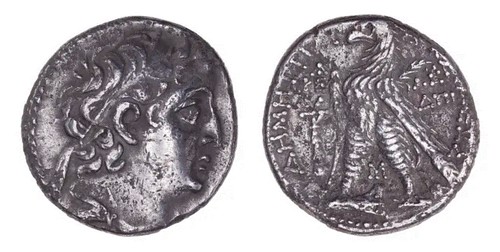
PREV ARTICLE
NEXT ARTICLE
FULL ISSUE
PREV FULL ISSUE
SELEUCID TETRADRACHM ISSUED BY DEMETRIUS II
Russell Atherton writes: "Interesting and significant fact about the coin featured in "Second Temple Period Shekel Rediscovered": It isn't a Tyrian shekel. It is a Seleucid tetradrachm issued by Demetrius II. It looks quite similar to the civic issues with the Melqart obverse, but the obverse is a portrait of Demetrius II. In fact, his name is clearly included on the reverse -- which of course never appears on the coins known as Tyrian shekels. Thanks for your faithful work in compiling this excellent weekly resource!" Bob Leonard writes: "The piece is illustrated, and on it we can read the name Demetri..., for the Seleucid king Demetrius II Nicator, 145-139, 129-125 BC, circa 129/28 BC (not sure if I am reading the date correctly, but this should be close). It is a tetradrachm, not a "shekel," though Tyrian shekels are really tetradrachms too, but were of sufficient weight to pay the half shekel Temple tax for two men. When Tyre became independent in 125 BC, it continued the design of the Seleucid tetradrachm, merely substituting the image of the god Melkart, patron deity of Tyre, for the Seleucid king, changing the reverse inscription, and adding a date based on the era of its independence. "The rarity of this coin is also much overrated. Some years ago I did a study of hoards of shekels of Tyre just from Israel (excluding Lebanon, where Tyre is actually located), and came up with 6,000 pieces or so in total; I have two varieties in my collection. For the actual tetradrachm of Demetrius II, the American Numismatic Society holds 38 examples." Thanks, everyone. -Editor
To read the earlier E-Sylum article, see:

Wayne Homren, Editor The Numismatic Bibliomania Society is a non-profit organization promoting numismatic literature. See our web site at coinbooks.org. To submit items for publication in The E-Sylum, write to the Editor at this address: whomren@gmail.com To subscribe go to: https://my.binhost.com/lists/listinfo/esylum All Rights Reserved. NBS Home Page Contact the NBS webmaster 
|